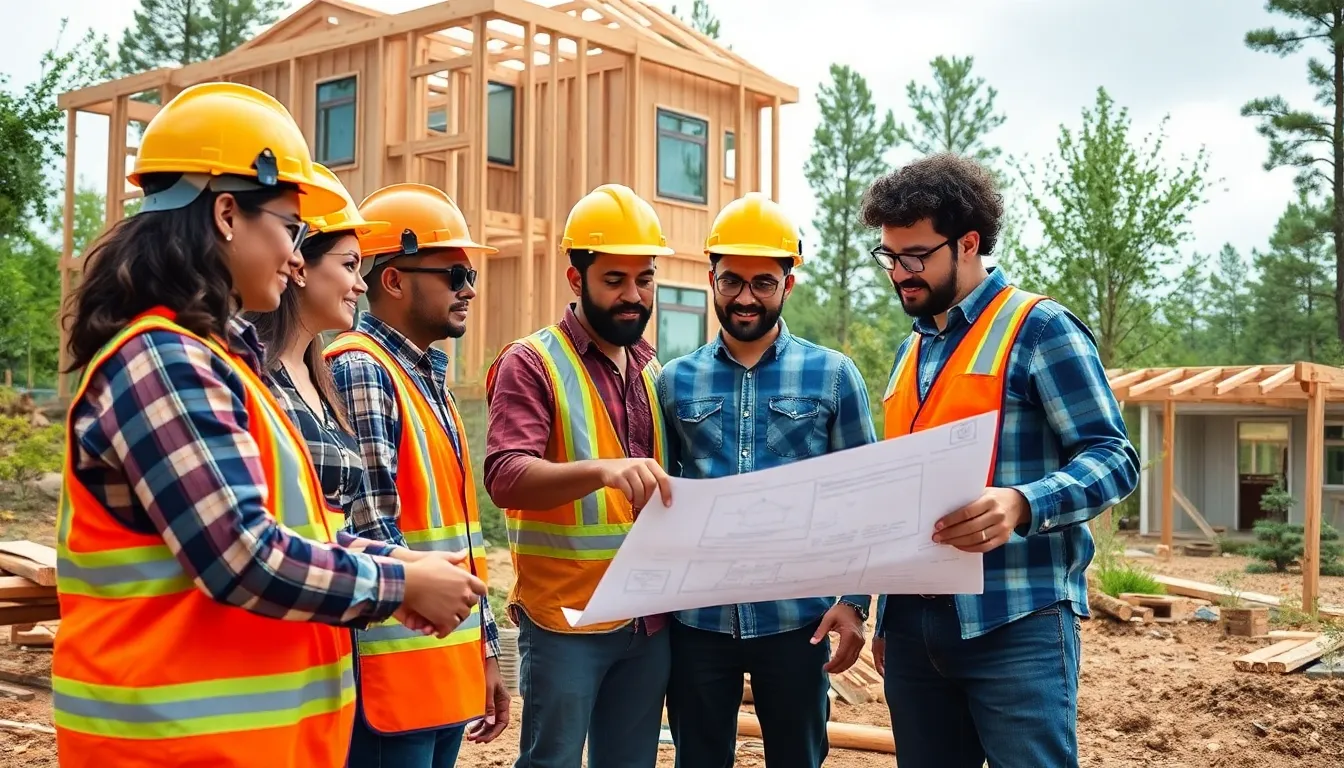In a world where eco-friendly choices often feel like a game of hide and seek, sustainable living builders are the superheroes we didn’t know we needed. Armed with bamboo, solar panels, and a hefty dose of creativity, they’re transforming the way we think about our homes. Forget the days of cookie-cutter houses; these builders are crafting spaces that not only look good but also do good for the planet.
Imagine living in a home that’s as kind to the Earth as it is to your wallet. With energy-efficient designs and sustainable materials, these builders are making green living not just a dream but a reality. So, whether you’re looking to build a cozy cottage in the woods or a sleek modern marvel, sustainable living builders are paving the way for a brighter, greener future—one eco-friendly brick at a time.
Table of Contents
ToggleWhat Are Sustainable Living Builders?
Sustainable living builders focus on eco-friendly construction practices. They prioritize reducing environmental impact through innovative techniques. Utilizing renewable resources like bamboo and recycled materials is common within this sector.
Energy efficiency drives their designs, as seen with the integration of solar panels and advanced insulation materials. These builders create homes that minimize reliance on fossil fuels while maximizing natural light and ventilation.
These builders emphasize unique home configurations. Rather than following conventional designs, they offer customized solutions that meet individual needs while adhering to sustainable principles. Their work contributes to the overall health of communities by incorporating green spaces and promoting biodiversity.
Education plays a key role in their approach, often providing homeowners with information on sustainable living practices. Clients find value in learning about energy-saving technologies and sustainable landscaping options.
Incorporating community input is crucial for sustainable living builders. They aim to engage local stakeholders, ensuring that projects reflect the community’s values and environmental goals. Feedback from residents can shape design choices and foster a sense of ownership in sustainable development projects.
Ultimately, the efforts of sustainable living builders create lasting benefits for both homeowners and the planet. By transforming how homes are constructed, they fulfill an essential role in the transition to a more sustainable future.
Benefits of Hiring Sustainable Living Builders

Sustainable living builders deliver numerous advantages, making them a valuable choice for eco-conscious homeowners. Their expertise in sustainable practices enhances both environmental and economic outcomes.
Environmental Impact
Sustainable living builders significantly reduce ecological footprints through eco-friendly construction methods. They utilize renewable resources like bamboo and recycled materials that minimize waste and resource depletion. Homes designed by these builders promote energy efficiency by integrating solar panels and advanced insulation systems. Such features lower dependence on fossil fuels, benefiting the environment. Emphasizing natural light and ventilation, these builders foster healthier indoor spaces for occupants. Green spaces incorporated into designs enhance local biodiversity, positively impacting community ecosystems.
Economic Savings
Economic benefits arise from hiring sustainable living builders. Energy-efficient homes typically incur lower utility costs, resulting in increased savings for homeowners over time. Many sustainable builders install technologies that optimize energy use and contribute to reduced reliance on traditional energy sources. Tax incentives for using renewable energy systems can further bolster financial advantages. Long-term durability of sustainably built homes minimizes maintenance expenses, allowing homeowners to allocate funds elsewhere. By choosing sustainable construction, homeowners invest in properties that appreciate in value within an increasingly eco-conscious market.
Key Features of Sustainable Homes
Sustainable homes incorporate innovative designs that foster environmental conservation and energy efficiency. Builders prioritize features that minimize ecological footprints while enhancing comfort for residents.
Energy Efficiency
Energy-efficient homes utilize advanced technologies to lower energy consumption. Incorporating solar panels enables harnessing renewable energy, significantly decreasing reliance on fossil fuels. Strategic placement of windows maximizes natural light, reducing the need for artificial lighting. High-quality insulation retains heat during colder months, contributing to overall comfort and energy savings. These features lead to measurable reductions in utility costs, offering financial benefits alongside environmental ones. Investing in energy-efficient solutions not only supports sustainable practices but also promotes healthier living spaces.
Eco-Friendly Materials
Eco-friendly materials form the backbone of sustainable home construction. Builders often select bamboo, a renewable resource that grows quickly and offers durability. Recycled materials, such as reclaimed wood or repurposed metal, minimize waste and reduce the demand for new resources. Using low-VOC paints ensures better indoor air quality, creating healthier environments. In addition, sustainably sourced materials contribute to the longevity of homes, ensuring they can withstand various environmental challenges. These choices reflect a commitment to reducing environmental impacts while providing beautiful, functional living spaces.
Choosing the Right Sustainable Living Builder
Selecting a suitable sustainable living builder requires careful consideration of various factors. Homeowners benefit from builders who demonstrate expertise in eco-friendly construction practices.
Certifications and Credentials
Verify certifications held by sustainable builders, as they often indicate compliance with industry standards. Look for credentials from organizations, such as the National Association of Home Builders and LEED certification. These qualifications highlight a builder’s commitment to sustainable practices. Additionally, homeowners can gain insight into the builder’s knowledge of green technology and environmentally conscious design principles by reviewing their credentials.
Project Portfolio
Examine the project portfolio of sustainable living builders to see past work and design styles. A diverse portfolio showcases the builder’s ability to create customized solutions while adhering to sustainable principles. Review completed projects for energy-efficient elements, such as solar panels and eco-friendly materials. Homeowners also look for projects that incorporate green spaces, which promote biodiversity and community health. Each project should reflect the builder’s unique approach to sustainable living, allowing potential clients to envision their eco-friendly homes.
Challenges in Sustainable Building
Sustainable building faces several challenges that can impact project execution and affordability. Costs associated with sourcing eco-friendly materials and implementing advanced technologies often exceed traditional building expenses. Builders factor in the use of renewable resources, like bamboo or recycled materials, which can involve higher initial investments. Budgeting becomes crucial, as homeowners must balance their desire for sustainability with financial constraints.
Costs and Budgeting
Costs remain a primary concern for sustainable builders. Budgeting for renewable materials and energy-efficient technologies incurs premiums that traditional construction may not reflect. While long-term savings on utility bills mitigate initial costs, homeowners might hesitate when comparing short-term expenses. Understanding potential tax incentives provides additional financial relief, making eco-friendly projects more appealing. A clear budget plan is essential, enabling builders and homeowners to prioritize key features that align with sustainability goals while avoiding overspending.
Regulations and Permits
Navigating regulations can complicate sustainable building projects. Local building codes often dictate specific requirements that builders must follow, sometimes conflicting with eco-friendly practices. Ensuring compliance with zoning laws and obtaining necessary permits adds time to project timelines. Sustainable living builders typically engage local authorities early in the process, facilitating smoother interactions. Staying informed of changes in regulations helps builders adjust their methods and designs accordingly, ensuring alignment with sustainable objectives while adhering to legal frameworks.
Sustainable living builders are paving the way for a greener future through innovative construction practices and eco-friendly designs. Their commitment to using renewable resources and energy-efficient technologies not only enhances the quality of life for homeowners but also contributes positively to the environment.
By prioritizing community engagement and education, these builders empower homeowners to embrace sustainable living. While challenges like initial costs and regulatory hurdles exist, the long-term benefits of energy savings and healthier living spaces far outweigh the drawbacks.
Choosing the right sustainable living builder is essential for those looking to create a home that reflects their values while supporting environmental stewardship. This choice can lead to a lasting impact on both individual lives and the planet.


